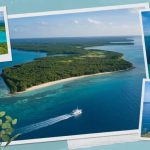Yukevalo Island – Routes, Attractions & More
Dreaming of white sandy beaches, turquoise waters, and unforgettable adventures? yukevalo island is the answer to your tropical vacation dreams. This stunning destination combines natural beauty with authentic cultural experiences, offering something truly special for every type of traveler.
Nestled in pristine waters, yukevalo island remains one of those rare gems that balances tourism with preservation. Unlike many overcrowded destinations, this island maintains its natural charm while providing the amenities modern travelers expect. The island’s diverse landscape features everything from powdery beaches and vibrant coral reefs to lush rainforests and scenic mountain viewpoints.
What sets yukevalo island apart from other tropical destinations is its commitment to sustainable tourism and the preservation of local culture. The island communities have embraced visitors while maintaining their traditional way of life, creating an authentic experience that feels worlds away from artificial tourist bubbles.
Yukevalo Island

Whether you’re seeking romantic seclusion, family-friendly activities, adrenaline-pumping adventures, or simply a peaceful retreat from busy life, yukevalo island delivers with its perfect combination of relaxation and excitement.
This comprehensive guide will walk you through everything you need to know to plan your perfect island getaway – from transportation options and accommodations to activities and local customs.
Planning Your Trip: When to Visit and What to Expect
Climate and Seasons
Understanding yukevalo island’s seasonal patterns will help you plan your perfect trip:
Dry Season (November to April)
- Weather characteristics: Sunny days, clear skies, minimal rainfall
- Temperature range: 75-88°F (24-31°C)
- Sea conditions: Calm waters with excellent visibility for snorkeling and diving
- Popularity: Peak tourist season, especially December through March
- Pricing: Higher rates for accommodations and activities
Wet Season (May to October)
- Weather characteristics: Brief afternoon showers, higher humidity, occasional stormy days
- Temperature range: 72-84°F (22-29°C)
- Sea conditions: Slightly choppier waters, occasional limitations on boat excursions
- Popularity: Fewer visitors, more peaceful atmosphere
- Pricing: Lower rates and better deals on accommodations
The sweet spots: Many experienced travelers consider May/June and September/October to be ideal times to visit, offering a good balance of favorable weather, fewer crowds, and better rates.
Special Seasonal Highlights
Depending on when you visit, you might experience these special natural phenomena and cultural events:
- Whale watching season: June to September offers the best chances to spot humpback whales during their migration
- Sea turtle nesting: February to May is when sea turtles come ashore to nest on protected beaches
- Harvest Festival: April brings colorful celebrations of local crops with music, dance, and feasting
- Founders’ Day: October features historical reenactments and cultural performances commemorating the island’s settlement
What to Pack
Essential items for any season:
- Lightweight, breathable clothing
- Multiple swimsuits
- Sun protection (high-SPF sunscreen, hat, sunglasses)
- Insect repellent
- Comfortable walking shoes for exploration
- Water shoes for rocky beaches and reef exploration
- Basic first-aid supplies and any personal medications
- Camera (waterproof if possible)
- Reusable water bottle
Wet season additions:
- Light rain jacket or poncho
- Quick-dry clothing
- Waterproof bag for electronics and valuables
Getting to Yukevalo Island: Transportation Guide
Reaching yukevalo island requires some planning, but the journey is well worth the effort. The slightly remote location is part of what keeps the island’s natural beauty preserved.
Step 1: International Travel
Your journey begins with a flight to one of two gateway airports:
Rivertown International Airport (RTA)
- Primary gateway with extensive international connections
- Larger terminal with more amenities and services
- Connected to major global hubs with daily flights
Pacific City International Airport (PCA)
- Secondary option with fewer international connections
- Sometimes offers better domestic transfer schedules
- Can be less crowded during peak season
Major airlines serving these airports:
- Frontier Airlines (budget-friendly options from North America and Europe)
- Spirit Airlines (competitive rates with various international connections)
- Alaska Airlines (more premium service, especially on Pacific routes)
Flight booking tips:
- Book 3-4 months in advance for best rates
- Check both gateway airports for potential savings
- Consider shoulder seasons for lower fares
- Look for package deals including airport transfers
Step 2: Domestic Transfer to the Island
After reaching the gateway city, you have two main options to reach yukevalo island:
Option A: Seaplane Service
The seaplane experience offers:
- Travel time: 30-45 minutes of spectacular flying
- Views: Breathtaking aerial perspectives of coastlines and reefs
- Schedule: Multiple daily departures (weather permitting)
- Cost: $150-300 per person each way
- Convenience: Often departs from terminals near the main airports
- Limitations: Strict baggage weight limits (typically 15-20kg total per person)
Leading seaplane operators:
- Island Wings Air Service
- Coastal Seaplanes
- Blue Sky Aviation
Booking advice: Reserve seaplane seats at least 6-8 weeks in advance during high season (December-March) as they often sell out. In low season, 2-3 weeks advance booking is usually sufficient.
Option B: Ferry Service
The ferry option provides:
- Travel time: 2-3 hours depending on sea conditions
- Experience: Relaxed journey with ocean views
- Schedule: Several daily departures in high season, reduced schedule in low season
- Cost: $40-80 per person each way
- Capacity: More generous luggage allowance
- Amenities: Indoor and outdoor seating, basic food service
Primary ferry operators:
- Yukevalo Express Ferry
- Island Hopper Lines
- Blue Water Connections
Booking advice: Ferries rarely sell out completely except during major holidays, but booking (1-2 weeks) is still recommended during high season to secure preferred departure times.
Where to Stay: Accommodation Options
Yukevalo Island offers a remarkable range of places to stay, catering to all preferences and budgets. Here’s a comprehensive overview of your options:
Luxury Resorts: Premium Indulgence
For those seeking the ultimate in comfort and amenities, yukevalo island’s luxury resorts offer world-class experiences.
Top luxury properties:
- Azure Bay Resort & Spa – Featuring overwater bungalows with glass floor panels, multiple infinity pools, and a renowned spa specializing in traditional healing treatments. Their underwater restaurant offers a unique dining experience among coral and fish.
- The Coral Pearl Retreat – This exclusive property offers private villas tucked into a lush hillside with panoramic ocean views. Each villa comes with butler service, private plunge pools, and customized experiences ranging from private beach dinners to helicopter tours.
- Yukevalo Grand Resort – A sprawling beachfront property combining traditional architecture with modern luxury. Features include spacious suites, a championship golf course, multiple restaurants, and a comprehensive water sports center.
What to expect at luxury properties:
- Premium accommodations with high-end amenities
- Multiple dining venues with international and local cuisine
- Extensive spa and wellness facilities
- Personalized service and exclusive experiences
- Price range: $400-1,200+ per night depending on room type and season
Boutique and Mid-Range Options: Quality and Character
For travelers seeking comfortable accommodations with distinctive character at more moderate prices:
Noteworthy mid-range properties:
- Island Breeze Hotel – A charming property with 45 rooms surrounding tropical gardens and a free-form pool. Their open-air restaurant specializes in fresh seafood and sunset cocktails.
- Palm Grove Cottages – Individual cottages with private verandas set in a coconut grove just steps from a quiet beach. Known for personalized service and home-cooked breakfasts featuring local ingredients.
- Seaside Boutique Resort – A stylish smaller property with individually designed rooms, an infinity pool overlooking the ocean, and a relaxed beachfront bar and restaurant.
What to expect at boutique and mid-range accommodations:
- Comfortable, well-appointed rooms with good amenities
- Personalized service and local knowledge
- Often family-owned with distinctive character
- At least one quality restaurant and bar on property
- Price range: $150-350 per night
Eco-Friendly Stays: Sustainable Paradise
For environmentally conscious travelers, yukevalo island offers several outstanding eco-lodges and sustainable accommodations.
Leading eco-friendly options:
- Green Haven Eco-Lodge – Powered entirely by solar energy with innovative water conservation systems. Accommodations are in bungalows built from sustainable materials with natural ventilation and minimal environmental impact.
- Treehouse Retreat – Unique accommodations in structures built around mature trees, connected by elevated walkways through the canopy. Focus on education and conservation with guided nature walks and wildlife observation platforms.
- Ocean Breeze Eco-Resort – Features bamboo bungalows, organic gardens supplying their farm-to-table restaurant, and strong community involvement including local craft workshops and cultural exchanges.
What sets eco-accommodations apart:
- Sustainable design and operation principles
- Lower environmental footprint
- Educational components about local ecosystems
- Community involvement and conservation support
- Price range: $120-400 per night
Budget-Friendly Accommodations: Island Life for Less
Traveling on a tighter budget doesn’t mean missing out on the yukevalo island experience:
Popular budget options:
- Yukevalo Beach Hostel – Offering both dormitory-style rooms and basic private accommodations with a lively social atmosphere, communal kitchen, and organized group activities.
- Islander Guesthouse – A family-run establishment providing simple, clean rooms with fans, basic amenities, and a communal terrace with hammocks.
- Sunrise Backpackers – Located near the main village with easy access to public beaches, local eateries, and transportation. Features include a small pool, book exchange, and helpful staff who can arrange activities.
What to expect at budget accommodations:
- Basic but clean facilities
- Often fan-cooled rather than air-conditioned
- Shared bathrooms in some cases
- Communal spaces for socializing and meeting other travelers
- Price range: $30-100 per night
Exploring Yukevalo Island: Activities and Experiences
The true magic of yukevalo island lies in its diverse offerings of experiences and activities. Here’s your guide to the best the island has to offer:
Water Adventures: Ocean Exploration
With its crystal-clear waters and rich marine ecosystems, yukevalo island is a paradise for water enthusiasts.
Snorkeling and Diving:
- Coral Garden Reef – A shallow reef accessible from several beaches, perfect for snorkelers of all levels with colorful coral formations and abundant tropical fish.
- Blue Wall – A dramatic drop-off for experienced divers, where the reef plunges from shallow depths to over 40 meters, offering sightings of larger marine species.
- Shipwreck Point – Site of a small cargo vessel that sank in the 1970s, now home to schools of fish, coral growth, and occasionally sea turtles.
Equipment and guidance:
- Snorkeling gear is available for rent from most resorts and beach shops ($5-15 per day)
- Several PADI-certified dive centers offer courses and guided experiences
- Introductory dives for beginners start around $80-100
Other water activities:
- Kayaking and Paddleboarding – Explore the coastline at your own pace, accessing secluded beaches and coves. Hourly and daily rentals available from most beaches.
- Sailing and Boat Tours – Options include sunset cruises, fishing charters, island-hopping adventures, and seasonal whale watching excursions.
- Surfing – The eastern shore offers several breaks suitable for different skill levels, with local surf schools providing lessons and board rentals.
Land Exploration: Nature and Adventure
Beyond its beaches, yukevalo island boasts diverse inland landscapes waiting to be explored.
Hiking and nature trails:
- Summit Trail – A challenging 4-hour round-trip hike to the island’s highest point, offering 360-degree views of the entire island and surrounding ocean.
- Waterfall Path – A moderate 2-hour trek through rainforest to a spectacular 30-meter waterfall with a natural swimming pool at its base.
- Coastal Discovery Walk – An easier 3-hour trail following the northern shoreline, passing through diverse ecosystems including mangroves, beach forests, and cliff-top viewpoints.
Wildlife experiences:
- Bird Watching Tours – Guided early morning walks to spot some of the 50+ bird species on the island, including several endemic species found nowhere else.
- Night Safari – Evening guided excursions reveal nocturnal creatures and sometimes bioluminescent phenomena in certain bays.
- Conservation Center Visits – Educational facilities focusing on marine life protection, turtle conservation, and coral reef preservation.
Cultural Immersion: Connecting with Island Life
To truly understand yukevalo island, take time to explore its cultural heritage and connect with local communities.
Village visits and cultural activities:
- Traditional Craft Workshops – Learn weaving, pottery, or wood carving techniques from skilled local artisans.
- Cooking Classes – Discover how to prepare traditional island dishes using fresh local ingredients, often including a market visit.
- Cultural Performances – Evening shows featuring traditional music, dance, and storytelling, usually offered weekly at larger resorts or cultural centers.
Historical sites:
- Heritage Museum – Small but informative museum in the main village documenting island history from ancient settlements to modern times.
- Old Lighthouse – Historical site offering panoramic views and exhibits about maritime traditions.
- Ancient Stone Structures – Mysterious formations on the northern shore with guided tours explaining their cultural significance.
Practical Information for Travelers
Getting Around the Island
- Bicycle rentals – Available from most accommodations and in villages ($8-15 per day), ideal for exploring flat coastal areas.
- Island shuttle buses – Connect major beaches and villages with regular schedules throughout the day ($3-5 per ride or $20 for a weekly pass).
- Taxis – Available in more developed areas with fixed rates between destinations (approximately $10-25 depending on distance).
- Car and scooter rentals – Limited but available from a few operators for those wanting maximum flexibility (from $40/day for scooters, $70/day for cars).
- Walking – Feasible between nearby beaches and within villages, with several dedicated walking paths connecting popular areas.
Dining and Food Experiences
- Resort restaurants – Range from casual beachfront cafés to fine dining, with most offering a mix of international dishes and local specialties.
- Local eateries – Found in villages and near public beaches, serving authentic island cuisine at reasonable prices.
- Street food – Available at the main village market and during local festivals, offering a chance to try traditional snacks and treats.
- Special dietary needs – Most larger establishments can accommodate vegetarian, vegan, and gluten-free diets with advance notice.
Must-try local specialties:
- Fresh-caught seafood prepared with local herbs and spices
- Tropical fruit smoothies and fresh coconut water
- Traditional root vegetable dishes are often served at community feasts
Health and Safety Considerations
- Sun protection is essential – use high-SPF sunscreen, wear hats and light cover-ups, and limit direct exposure during peak hours (10am-2pm).
- Stay hydrated with bottled or purified water, which is widely available.
- Basic medical care is available at the island clinic, but serious conditions require evacuation to mainland hospitals. Comprehensive travel insurance with medical evacuation coverage is strongly recommended.
- Water safety – follow local advice about currents and swimming conditions, which can vary by season and location.
- Insect protection – use repellent, particularly during dawn and dusk hours and when visiting forested areas.
Frequently Asked Questions
- How do I get to Yukevalo Island?
First, fly to either Rivertown International Airport or Pacific City International Airport. From there, take either a 30-45 minute seaplane flight or a 2-3 hour ferry ride to reach the island. Seaplanes offer faster travel with spectacular views but at a higher cost, while ferries provide a more budget-friendly option with a relaxed journey.
- What is the best time to visit Yukevalo Island?
The dry season (November to April) offers the most reliable weather, with December to March being peak season. May/June and September/October are excellent times to visit with good weather, fewer crowds, and better rates. The wet season (May to October) features occasional showers but significantly lower prices.
- How many days should I spend on Yukevalo Island?
A minimum of 5-7 days is recommended to experience the island’s highlights without rushing. For a more relaxed pace and deeper exploration, 10-14 days would be ideal.
- Is Yukevalo Island family-friendly?
Yes, many resorts offer family-friendly accommodations and activities. The calm beaches, gentle hiking trails, and wildlife experiences are particularly suitable for children. Some properties offer kids’ clubs and special programs for younger visitors.
- What languages are spoken on Yukevalo Island?
English is widely spoken in tourist areas and establishments. The local population also speaks their traditional language, and many service staff speak additional languages such as Spanish, French, and Japanese.
- Do I need a visa to visit Yukevalo Island?
Visa requirements depend on your nationality. Many countries have visa-free arrangements for tourists staying less than 30 days. Check with your nearest embassy or consulate well before your trip.
- Can I drink the tap water on Yukevalo Island?
It’s recommended to drink bottled or purified water, which is widely available at accommodations and shops. Most resorts provide clean drinking water for guests.
- What type of electrical outlets are used on Yukevalo Island?
The island uses 220-240V with Type G plugs (three rectangular pins). Many accommodations provide adapters, but it’s wise to bring your own if you’re bringing electronics.
- Is there internet and cell phone service on Yukevalo Island?
Wi-Fi is available at most accommodations and many restaurants, though connection speeds may be slower than you’re accustomed to. Mobile phone coverage is generally good in developed areas but can be limited in remote parts of the island.
- How much should I budget daily for Yukevalo Island?
Daily budgets vary widely depending on your travel style:
- Budget travelers can manage on $80-150 per day, including simple accommodation, local food, and basic activities
- Mid-range travelers should budget $150-300 per day
- Luxury experiences typically require $300-600+ per day. These estimates don’t include international flights or domestic transfers to the island.
Also Check:
Final Tips for an Unforgettable Yukevalo Experience
To make the most of your yukevalo island adventure:
- Slow down and embrace island time – Don’t try to pack too much into each day. Leave room in your schedule for spontaneous discoveries and simple pleasures.
- Venture beyond your resort – While luxury properties offer many amenities, some of the most authentic and memorable experiences happen when you explore local villages and less-visited areas.
- Respect local customs – Learn about and observe cultural practices, ask permission before taking photos of people, and dress modestly when visiting villages or religious sites.
- Support the local economy – Purchase souvenirs directly from artisans, eat at locally-owned restaurants, and choose activities operated by island residents when possible.
- Practice responsible tourism – Follow environmental guidelines, avoid touching marine life while snorkeling or diving, properly dispose of waste, and minimize water and energy consumption.
Whether you’re seeking adventure, relaxation, cultural immersion, or a combination of all three, yukevalo island offers the perfect setting for creating memories that will last a lifetime. From the moment you glimpse its shores from your approaching seaplane or ferry until your reluctant departure, this island paradise will work its magic on you – just as it has for travelers before you and will continue to do for those who follow in your footsteps.








